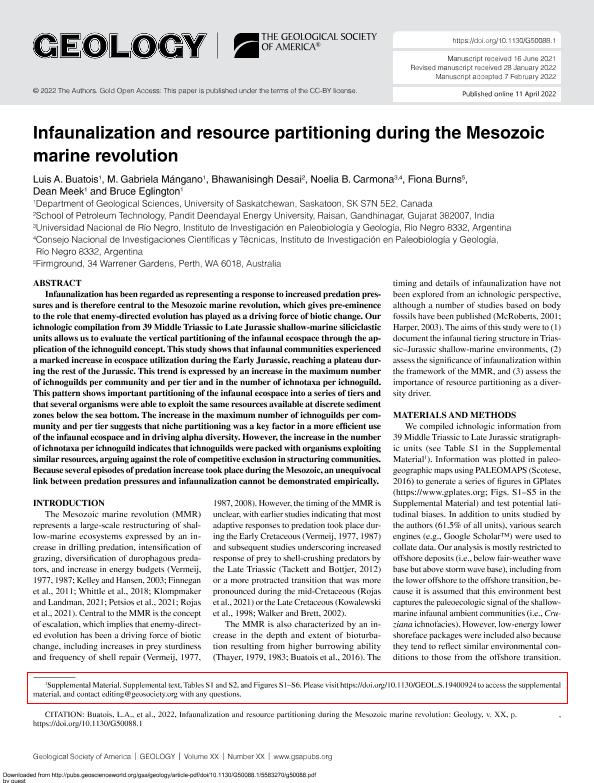Mostrar el registro sencillo del ítem
dc.contributor.author
Buatois, Luis Alberto

dc.contributor.author
Mángano, M. Gabriela
dc.contributor.author
Desai, Bhawanisingh
dc.contributor.author
Carmona, Noelia Beatriz

dc.contributor.author
Burns, Fiona
dc.contributor.author
Meek, Dean
dc.contributor.author
Eglington, Bruce
dc.date.available
2023-07-04T13:05:15Z
dc.date.issued
2022-07
dc.identifier.citation
Buatois, Luis Alberto; Mángano, M. Gabriela; Desai, Bhawanisingh; Carmona, Noelia Beatriz; Burns, Fiona; et al.; Infaunalization and resource partitioning during the Mesozoic marine revolution; Geological Society of America; Geology; 50; 7; 7-2022; 786-790
dc.identifier.issn
0091-7613
dc.identifier.uri
http://hdl.handle.net/11336/202192
dc.description.abstract
Infaunalization has been regarded as representing a response to increased predation pressures and is therefore central to the Mesozoic marine revolution, which gives pre-eminence to the role that enemy-directed evolution has played as a driving force of biotic change. Our ichnologic compilation from 39 Middle Triassic to Late Jurassic shallow-marine siliciclastic units allows us to evaluate the vertical partitioning of the infaunal ecospace through the application of the ichnoguild concept. This study shows that infaunal communities experienced a marked increase in ecospace utilization during the Early Jurassic, reaching a plateau during the rest of the Jurassic. This trend is expressed by an increase in the maximum number of ichnoguilds per community and per tier and in the number of ichnotaxa per ichnoguild. This pattern shows important partitioning of the infaunal ecospace into a series of tiers and that several organisms were able to exploit the same resources available at discrete sediment zones below the sea bottom. The increase in the maximum number of ichnoguilds per community and per tier suggests that niche partitioning was a key factor in a more efficient use of the infaunal ecospace and in driving alpha diversity. However, the increase in the number of ichnotaxa per ichnoguild indicates that ichnoguilds were packed with organisms exploiting similar resources, arguing against the role of competitive exclusion in structuring communities. Because several episodes of predation increase took place during the Mesozoic, an unequivocal link between predation pressures and infaunalization cannot be demonstrated empirically.
dc.format
application/pdf
dc.language.iso
eng
dc.publisher
Geological Society of America

dc.rights
info:eu-repo/semantics/openAccess
dc.rights.uri
https://creativecommons.org/licenses/by/2.5/ar/
dc.subject
Ichnology
dc.subject
Mesozoic Marine Revolution
dc.subject.classification
Paleontología

dc.subject.classification
Ciencias de la Tierra y relacionadas con el Medio Ambiente

dc.subject.classification
CIENCIAS NATURALES Y EXACTAS

dc.title
Infaunalization and resource partitioning during the Mesozoic marine revolution
dc.type
info:eu-repo/semantics/article
dc.type
info:ar-repo/semantics/artículo
dc.type
info:eu-repo/semantics/publishedVersion
dc.date.updated
2023-07-03T15:18:00Z
dc.identifier.eissn
1943-2682
dc.journal.volume
50
dc.journal.number
7
dc.journal.pagination
786-790
dc.journal.pais
Estados Unidos

dc.journal.ciudad
Boulder
dc.description.fil
Fil: Buatois, Luis Alberto. University of Saskatchewan; Canadá. Consejo Nacional de Investigaciones Científicas y Técnicas; Argentina
dc.description.fil
Fil: Mángano, M. Gabriela. University of Saskatchewan; Canadá
dc.description.fil
Fil: Desai, Bhawanisingh. Pandit Deendayal Energy University; India
dc.description.fil
Fil: Carmona, Noelia Beatriz. Consejo Nacional de Investigaciones Científicas y Técnicas. Centro Científico Tecnológico Conicet - Patagonia Norte. Instituto de Investigación en Paleobiología y Geología; Argentina
dc.description.fil
Fil: Burns, Fiona. Firmground; Australia
dc.description.fil
Fil: Meek, Dean. University of Saskatchewan; Canadá
dc.description.fil
Fil: Eglington, Bruce. University of Saskatchewan; Canadá
dc.journal.title
Geology

dc.relation.alternativeid
info:eu-repo/semantics/altIdentifier/doi/http://dx.doi.org/10.1130/G50088.1
dc.relation.alternativeid
info:eu-repo/semantics/altIdentifier/url/https://pubs.geoscienceworld.org/gsa/geology/article/50/7/786/612997/Infaunalization-and-resource-partitioning-during
Archivos asociados
